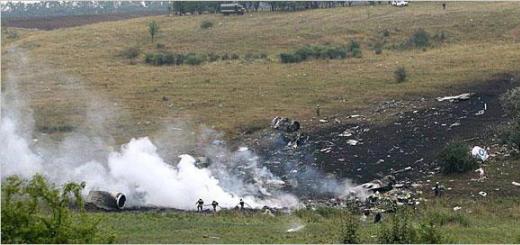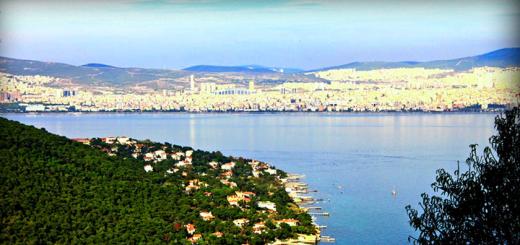On April 2, 2012, an ATR-72 plane of UTair Aviation, performing the flight Tyumen - Surgut,. According to preliminary data, there were 43 people on board - 39 passengers and four crew members. According to the Ministry of Emergency Situations, 31 people died, 12 were injured.
On August 9, 2011, during the takeoff of the ATR-72 aircraft from Medan (Indonesia), the right engine of the liner caught fire. The plane landed safely three minutes after departure, there were no casualties.
On July 14, 2011, Eurolot's ATR-72 was damaged in a collision with a luggage vehicle at Warsaw Chopin Airport (Poland). The car crashed into the engine, one of the propeller blades pierced the aircraft fuselage. Driver vehicle was seriously injured.
On November 4, 2010, in the province of Sancti Spiritus (Cuba), at an altitude of about 6 thousand meters, the ATR-72 aircraft of Aerocaribbean received icing in adverse weather conditions, lost altitude and crashed in the mountains. All 68 people on board were killed.
On November 10, 2009, a Kingfisher Airlines ATR-72 passenger aircraft was damaged when it rolled off the runway while landing at Mumbai International Airport, India. There were no casualties.
On July 1, 2007, an accident occurred with the ATR-72 aircraft at the Indore airport (India). The plane made a hard landing, rolling off the runway in heavy rain. There were no casualties.
On August 6, 2005, a passenger plane ATR-72 of the Tunisian airline Tuninter, flying from Italian city Bari to tunisian resort town Djerba attempted a water landing 13 miles off the coast of Sicily. There were 39 people on board, 16 people were killed - 14 passengers and 2 crew members.
The cause of the disaster was the lack of fuel, which required the commander of the ship to make an emergency splashdown. The lack of fuel was caused by a malfunction of the sensor, which shows the level of fuel in the aircraft tanks.
May 9, 2004 as a result emergency landing at the San Juan airport (Puerto Rico), when an American Eagle ATR-72 aircraft landed, one of the landing gear tires exploded and the aircraft rolled off the runway, tilting onto its left wing. Onboard there were 22 passengers and four crew members. 13 passengers received various injuries and were hospitalized, there were no deaths.
Dedicated to the memory of the dead and injured passengers of the failed flight.
Tyumen airport Roshchino - international Airport federal significance. The airfield of the Roshchino airport is equipped with two class B runways: one 3000 meters long and 45 meters wide, with asphalt concrete, the second asphalt, 2700 meters long and 50 meters wide.
On April 2, 2012, it was cloudy at the Tyumen airport, it was pouring snow, turning into a blizzard, a southwestern wind was blowing at a speed of 6 m / s (in gusts up to 15 m / s). There was significant cloudiness - 390 meters high, the clouds were cumulonimbus in shape. The temperature was -1 ° C, the pressure was 1000 hectopascals. The visibility was 1,500 meters.
At 0530 hours Moscow time, according to the schedule, the ATR-72 plane with flight number 120 Tyumen - Surgut was preparing for takeoff from the first, main strip.
IN THE PASSENGER SALON
Behind the agonizing minutes of pre-flight registration and boarding. People gradually figured out hand luggage, outerwear and began to get comfortable in soft chairs. Onboard there were 39 passengers and 4 crew members. There were no children on the plane. The oldest passenger was 69 years old, the youngest was 22 years old.
The flight attendant, lightly touching the microphone mesh with her lips, introduced the passengers to the crew with a professional intonation in her voice, explained the location and purpose of some parts and devices in the cabin, suggested wearing seat belts and wished them a pleasant flight.
The warmed-up turbines of the aircraft began to sing. The stewardess walked through the cabin and carefully checked the position of the seat belts in each occupied seat. In the meantime, the liner taxied to the starting position and, having received the dispatcher's permission, began to vigorously accelerate. The force of acceleration gently pressed the passengers into the backrests. The work of the shock absorbers on the runway was transmitted to the aircraft body and felt in the cabin in the form of shaking and knocking. But then the vibrations stopped, the plane broke away from runway, began to gain altitude under the even hum of powerful engines. The passengers calmed down and slowly prepared for the long flight.
IN THE PILOT'S CABIN
Almost immediately after taking off from the runway, the pilots unexpectedly discovered that the car had gone out of their control and was refusing to gain further altitude.
According to the transcript of the conversations on the flight recorders, after turning on the autopilot and trying to remove the flaps, the plane began to shake. The crew commander switched to manual control, but the plane made a sharp roll to the right and began to lose altitude. The pilots tried to straighten it, but the ATR-72 continued to lose altitude and began to roll to the left wing.
Recording of pilots' conversations in a "black box" in time (PIC - aircraft commander; 2P - co-pilot; RI - voice informant):
07:33:53 PIC: Autopilot on.
07:33:55 2P: Autopilot on.
07: 34: 00: 14 PIC: White bug flars up.
07: 34: 08: 07 2P: Wow ... wow!
07: 34: 09: 01 PIC: What is it?
07: 34: 09: 19 2P: What kind of shaking?
07: 34: 11: 15 PIC: Autopilot disencage.
07: 34: 16: 26 2P: Quiet, what is it?
07: 34: 18: 28 PIC: Tell him ...
07: 34: 20: 06 RI: Pont sink! (automatic information: 120 meters left to the ground).
07: 34: 23: 17 2P: What to report, b ... b? What kind of refusal?
07: 34: 25: 05 FAC: I don’t understand.
07: 34: 30: 23 2P: Y. your mother!
07: 34: 30: 35 FAC: UTR, one hundred and twentieth, falling ...
An interesting message was found on the Internet: “My mother works, something like a watchman in a residential building and one girl from there (from among the survivors of the accident - A.S.). The girl's parents say that she does not speak yet, but is already writing. He says that it was mainly those who sat in the tail of the plane that were lucky. And the stewardess ran when the plane was forced to land, spoke and showed everyone how to sit down and how to close. "
This means that the flight attendants realized an imminent forced landing and tried to save the lives of passengers in the last thirty seconds of the flight, without thinking about their own.
As the investigators clarified, the plane, while climbing, dodged first to the right, then to the left of the course and tried to make an emergency landing, but hit the ground with the left engine and fell apart.
According to investigators, the pilots did not understand why the plane began to lose altitude.
Most likely, this is not entirely true. The houses of the village of Gorkovka loomed two kilometers straight ahead. The naughty plane, meanwhile, was rapidly losing altitude gained during takeoff, threatening an inevitable fall on awakening houses. It is unlikely that the liner commander Sergei Antsin at these moments remembered the words of the popular song: "Let us die, but we will save the city"! But he knew well the vicinity of the airport, where there was a vast snow-covered field just beyond the edge of the runway. The commander managed to assess the situation, after eleven seconds he switched from autopilot to manual control and decided to make an emergency landing of the aircraft. In the remaining moments of the flight, it turned out to be impossible to completely take control of the hard-to-control aircraft. As a result of a hard landing, it collapsed into several parts and caught fire.
The landing site of the plane was only 800 meters in front of residential buildings, from which it was separated only by a small grove with a local cemetery located in it.
ON THE GROUND
According to the Ministry of Emergency Situations in the Tyumen region, the incident occurred at 7.44 local time (5.44 Moscow time). Airplane, airline-owned UTair took off from the Tyumen airport Roshchino to Surgut by flight UT120 (according to the schedule on the company's website, the board departed at 07.30, in Surgut the board was supposed to land at 09.15). A few minutes after takeoff, the plane disappeared from the radar screen, and the crew did not contact the dispatcher. According to the crew of the other side, which took off from the Roshchino airport after, the ATR-72 aircraft with tail number VP-BYZ crashed about 3-5 kilometers from the runway, near the village of Gorkovka.
The rescue services responded very quickly and ten minutes later the Emergencies Ministry's all-terrain vehicles and ambulances arrived at the plane's landing area.
The fire at the crash site was quickly extinguished, and the dismantling of the structures began. crashed plane, search and rescue of surviving passengers.
By 10.00 am Moscow time, 232 employees of the main department of the Ministry of Emergency Situations of Russia in the Tyumen region and 125 pieces of equipment were working at the scene. In parallel, investigators and criminologists began to work.
The plane crash killed 31 people, including the entire crew, 12 people survived. The victims were taken to the regional clinical hospital No. 2 in Tyumen. By 13 o'clock, seven people had been operated on, and five more were on the operating tables. By this time, two patients were in an extremely serious condition, the condition of the rest was assessed by doctors as very serious.
At the crash site, rescuers found both black boxes of the aircraft, which were handed over to specialists.
Investigators began working with the surviving passengers whose health conditions allowed them to testify.
At the Roshchino airport, technical and pre-flight documentation was confiscated at the UTair - Engineering company, which monitored the condition of the aircraft. According to the investigation, the board was released in 1991 and put into operation in 1992. The plane flew 35 thousand hours. The last serious maintenance of the aircraft took place in Germany in 2010, and it underwent scheduled maintenance in Tyumen two months ago.
ATR-72 is a passenger twin-engine turboprop aircraft for medium-haul flights. Designed to carry up to 74 people of the same class at medium distances and is operated by two pilots. The ATR-72 aircraft was developed on the basis of the ATR-42. The developers lengthened the fuselage by 4.5 meters, increased the wingspan, the fuel tank by 10%, and equipped the aircraft with more powerful engines. The start of work on the creation of ATR-72 was announced in 1986, the first flight was made on October 28, 1988. On April 2, 2012, 14 ATP-72 aircraft were lost (worldwide).
The Ural Investigative Directorate of Transport of the Investigative Committee of Russia opened a criminal case under Part 3 of Art. 263 of the Criminal Code (violation of traffic safety rules and the operation of air transport, resulting in the death of two or more persons by negligence).
The investigators considered the technical malfunction of the aircraft, the error of pilots or dispatchers as priority versions.
UTair has published a list of 39 passengers and four crew members on board. The airline sold 40 tickets for this flight, but one passenger - a resident of the Khanty-Mansiysk Autonomous Okrug - did not arrive at the place of departure. But this person now has every right to celebrate his birthday twice a year.
One of the victims of the plane crash near Tyumen died in the regional clinical hospital No. 2. On the night of April 19, another victim died. Thus, the death toll has increased to 33 people.
Three victims of the plane crash were sent to Moscow for further treatment.
IN THE TOWN
Tyumen residents eagerly caught messages from the scene. The plane crash changed the minds of many townspeople. Reality was perceived in a completely different way, when a terrible tragedy occurred not far away, but somewhere very close, under the city. Our fellow countrymen died, the townspeople with whom we walked along the same streets, met by chance. The news of the crashed plane made one forget about the events that had seemed significant before in the life of the city. The tragedy awakened in people the best feelings of compassion and complicity.
The residents of Tyumen responded more than actively to the call to donate blood for the victims. The blood transfusion station has never seen such a frenzy: more than 600 people applied there per day, 460 of them became donors on April 2.
At about 4 pm, relatives of the passengers of the crashed plane flew to Tyumen from Surgut. They were accommodated in the Vostok Hotel. Psychologists began to work with relatives of the victims of the plane crash, including specialists from the Emergency Psychological Aid Center of the Russian Emergencies Ministry, headed by Yulia Shoigu.
The relatives of those killed and injured in the plane crash were in a serious mental state. Many of them were in shock, some were hysterical. 25 psychologists worked with the families of the victims of the disaster - these are specialists from Tyumen and their colleagues from Yekaterinburg and Moscow. All specialists had a higher psychological education and a proven track record. Psychologists accompanied Tyumen residents and people who arrived in our city from Surgut in hospitals where the wounded are located, as well as during victim identification procedures and during trips to the place where the tragedy happened.
On the first day of mourning, announced because of the fall of ATP-72, farewell ceremonies and funerals of the victims of the plane crash were held in the Tyumen region. On Wednesday, they buried those who were identified almost immediately after the tragedy, that is, on April 3 (by this time, relatives had already identified 26 of the 31 dead). The day before, the operational headquarters said that they had to say goodbye to at least nine dead, including the crew members and flight attendants. The commander of the crew, Sergei Antsin, was to be buried in Surgut.
For two and a half months, caring Russians transferred funds for the victims to a special account of the Tyumen Regional Medical Society.
Tyumen, Surgut, Zelenogorsk, Togliatti, St. Petersburg, Moscow, Krasnodar, Perm, Khanty-Mansiysk, Vorkuta, New Urengoy, Nefteyugansk, Beloyarsky, Gornopravdinsk, Salekhard, Nizhnevartovsk, Yekaterinburg, Tver, Irkutsk, Voronezh, Chelyabinsk, Nadym, Urai, Saratov, Bratsk, Samara - this is the geography of transfers. In total, 688,700 rubles were donated to the charitable account.
By decision of a special commission, these funds were allocated in equal shares to provide assistance to minor children of those killed and injured in the plane crash. There are 25 minor children on the list. Each of them was credited with 27 thousand 500 rubles. The money was transferred to open accounts in the branches of OJSC West Siberian Bank of Sberbank of Russia
The amount of compensation to the families of those killed in the plane crash near Tyumen was one and a half million rubles. This order was signed by the governor of the Tyumen region.
According to the governor's press service, people who survived the accident will receive compensation in the amount of one million.
UTair Aviation undertook to pay 2 million rubles each to the families of the victims. The same amount should be received by the victims of the plane crash.
The firefighters of a separate post in the village of Gorkovka, who were the first to arrive at the crash site of the ATR-72 liner, were nominated for the medal "For saving the dead".
In total, the incentive list includes about 80 employees of the Tyumen Department of the Ministry of Emergency Situations who took part in the rescue operation and the liquidation of the plane crash.
30 fighters were nominated for departmental awards, another 30 rescuers will receive cash bonuses, certificates of honor and gratitude for courage and heroism, and 15 people will be encouraged by the Ural regional center of the Ministry of Emergencies.
IN THE INVESTIGATING COMMITTEE
The International Aviation Committee (IAC) named the reasons for the fall of the ATR-72 aircraft near Tyumen.
On July 16, 2013, the commission of the Interstate Aviation Committee published the final report, which lists in detail all the reasons for the plane crash near Tyumen.
On April 2, 2012 at 07:33 local time near the village of Gorkovka, shortly after takeoff from Roshchino airport, an ATR-72 plane fell 1.5 km from the end of the runway, collapsed and partially burned out. Onboard there were 39 passengers and 4 crew members: 31 people were killed and 12 were hospitalized. Later, two more passengers were added to the list of the dead.
The direct cause of the ATR-72 plane crash near Gorkovka on April 2, 2012, according to experts, was the decision of the aircraft commander to take off without de-icing the vessel covered with snow and ice in the presence of snow and ice deposits on the plane's surface.
These factors led to a deterioration in the aerodynamic characteristics of the aircraft, its stall in the climb after takeoff, more precisely, after retracting the flaps. The crew did not react to the dangerous regime in time, as stated in the document.
The main blame was placed on the crew. It is noted that the deceased commander of the plane was brought in as the accused. No alcohol was found in the blood of the pilots of the plane that crashed near Tyumen.
Two employees of UTair-Technic were also charged in the case of a plane crash in the Tyumen region. In this regard, the Investigative Committee of Russia reported: "The investigation has collected sufficient evidence confirming the guilt of the shift supervisor and aircraft mechanic of UTair-Technic LLC in the crash of the indicated aircraft."
As proof of the version that the cause of the disaster could have been the lack of anti-icing treatment, an excerpt from a telegram sent by the Federal Air Transport Agency to all carriers on April 6 is given. It follows from it: the ground services of the Tyumen airport grossly violated the safety requirements. The plane stood under a heavy snowfall for eight hours, but it was never treated with an anti-icer.
In addition, among the reasons aviation accident shortcomings in the organization of ground handling of the aircraft and training of personnel at UTair-Technic LLC, lack of control by the management and the shift supervisor, incorrect assessment of the state of the aircraft surface after spending the night under snow and rain are indicated.
Among the contributing factors, a whole list of disadvantages is indicated, in particular:
- in the UTair flight safety management system;
- in quality management of UTair-Technic LLC;
- in the initial and periodic training of crew members (in terms of understanding the degree of danger of taking off with unrepaired ground icing);
- violation of the work and rest regime during flight shifts, vacation arrears.
Based on the results of the investigation, recommendations were developed to improve flight safety, the IAC reports.
AT THE SITE OF THE DISASTER
Proactive people announced an all-Russian competition on the Internet for a monument to the victims of the Tyumen tragedy. Several dozen works were submitted to the competition, including those from nonresident authors.
Eleven models of obelisks made of cardboard and plasticine were exhibited for discussion in the premises of the Tyumen Literary and Local Lore Center. Naturally, within the time frame limited by the terms of the competition, everything was worked out roughly, in haste. But the winner was named. Immediately, as from the ground, a certain "public" appeared, which came to the conclusion that this trivial monument should be erected in any way in the center of the city and not otherwise than on the Square of Memory of the Fallen in Velikaya Patriotic War or on the embankment of Tours.
However, the actions of the initiators of the competition caused a negative reaction from the relatives of the victims of the accident, who, firstly, were outraged that the public was unceremoniously discussing their purely personal topic, and, secondly, they collectively tended to limit themselves to the obelisk at the scene of the tragedy.
The relatives also expressed their hope that a road will be laid, along which, in this case, it will be possible to come to the monument at any time of the year.
Expression of the will of relatives was decisive. They abandoned the idea of building a large obelisk. A modest monument to the victims of the plane crash was placed in the middle of an oat field at the site of the plane crash behind the Gorky rural cemetery. It is about twenty kilometers from the city.
It is not easy to get to the memorial site from the asphalt highway. And in bad weather on a two-kilometer bumpy field dirt road in a car to the monument and not at all break through. The embodiment of the aspirations of relatives to fill the road with rubble, alas, did not come true.
The monument is located ten meters from the field road. For the whole summer, not a single path was laid to it through the virgin thickets of oats, although it is known that 31 people, that is, most of the people on board, lived in Tyumen. During this period, the deceased and their relatives probably had joint memorable dates in their lives, but no one remembered this, did not visit ...
A large bowed cross made of wood and a two-meter-high granite block, on the dark polished edge of which the date of the crash of Flight 120 and the names of thirty-three dead are engraved, rise in the middle of the cornfield. It is completely unreasonable that the list does not mention passengers who miraculously survived the crash and remained for life with grievous bodily harm and traumatized psyche.
In front of the monument there is a large boardwalk for funeral ceremonies, through the cracks of which one meter stems of quinoa, sow thistle and other weeds make their way. The entrepreneurial little people are beginning to dismantle the left edge of the platform little by little into planks.
On the pedestal in front of the obelisk-stone, decorative lamps from long-burnt candles were piled up, and the dried stems of mummies of flowers, chaotically scattered by the field winds.
At the foot of the veneration cross lie in a heap all sorts of parts and wrecks of the aircraft, which are still found in the vicinity and carefully brought to the monument.
Among the wreckage is a fragment of a table from the back of a passenger seat with brown caked stains of someone's blood and an inscription in Russian and English: "Fasten your seat belt while in the seat." Perhaps this inscription and desperate, selfless actions in the last seconds of the flight of young flight attendants - red-haired, "sunny" 23-year-old Lyubochka Boldyreva and 30-year-old brunette beauty Masha Berdnikova, saved ten human lives.
This summer, here, apparently, no one remembered the dead, did not mourn, did not light candles, did not read prayers for the repose.
The abandonment of the monument is a sad testimony of how short human memory is.
Alexander Sokhansky
August 2014
INSTEAD OF AN AFTERWORD:
The Tyumen District Court announced the verdict in the criminal case on the crash of a UTair ATR-72 passenger plane in 2012, which killed 33 people and received 10 serious injuries. This was reported to TASS in court.
Shift supervisor Anatoly Petrochenko, UTair-Technik aircraft mechanic Andrey Pisarev and the deceased aircraft commander Sergei Antsin were found guilty.
“Petrochenko and Pisarev were sentenced to five years and one month in prison in a colony-settlement. The criminal case against Antsin was terminated due to his death,” the agency's source said. The court's decision has not yet entered into legal force and can be appealed.
The plane crash occurred on April 2, 2012. In August 2014, the shift supervisor, the UTair-Technik aircraft mechanic, as well as the representative of the deceased aircraft commander Sergei Antsin, his father, appeared before the court. The defendants are accused of violating traffic safety rules and the operation of air transport. "The prosecutor asked to be found guilty and to impose a sentence of six and five and a half years in a penal colony-settlement. With regard to Sergei Antsin, the criminal case should be dropped in connection with his death," the court said.
According to the Ural Investigative Directorate for Transport of the Investigative Committee of the Russian Federation, the immediate cause of the crash was the presence of snow and ice on the plane's surface. It is assumed that the skin has become iced while at rest and the aircraft has not been de-iced. According to the investigation, the preparation of the aircraft for the flight was not carried out in full. During the investigation of the criminal case, 57 examinations were carried out: commission forensic examination of fuels and lubricants, aviation technical, forensic, forensic, forensic medical examinations. The volume of the criminal case amounted to 139 volumes.
"It is assumed that the cladding is iced up ..." Based on assumptions, the court sentenced people to five years in prison!
Long live our court, the fairest court in the world!
Tyumen. April 1st. INTERFAX-URAL - The Tyumen Regional Court upheld the verdict in the case of the ATTR-72 plane crash near Tyumen in April 2012, which killed 33 people, the Tyumen Transport Prosecutor's Office told Interfax-Ural on Friday.
"The convicted shift supervisor Anatoly Petrochenko and the aircraft mechanic of UTair-Technic LLC Andrei Pisarev asked to cancel the sentence and acquit them, or mitigate the punishment, and the victims believed that the airline's management was not punished," said a spokesman for the department. He also added that the regional court, having considered the case, left the verdict unchanged, and the complaints of the convicted and victims were not satisfied.
Earlier it was reported that on November 30 last year, the Tyumensky District Court found A. Petrochenko and A. Pisarev guilty under the article "violation of traffic safety rules and the operation of air transport, resulting in the death of more than two persons by negligence" and sentenced each to 5 years and 1 month in prison -settlement.
The commander of the ATTR-72 aircraft Sergey Antsin, who died along with the passengers and other crew members, was also found guilty under the same article. There were no grounds for his rehabilitation, but the case against him was dropped due to his death. As usual - the silent dead is to blame for everything ...
According to the investigation, on April 2, 2012, the ATR-72 aircraft, performing the Tyumen-Surgut flight, took off from the Roshchino airport in Tyumen and crashed, falling 1.5 km from the runway near the village of Gorkovka in Tyumenskaya area. The disaster killed 33 people and injured 10 people.
During the investigation, 57 examinations were carried out. The volume of the criminal case amounted to more than 130 volumes.
It was established that the immediate cause of the accident was the presence of snow and ice deposits on the aircraft surface due to ground icing during parking, incomplete preparation of the aircraft for flight, including the failure to carry out anti-icing treatment of the aircraft.
S T A T I S T I K A P A D E N I J A T R - 7 2:
* The ATR 72 crash near Rozlon was a plane crash that occurred on Halloween on Monday 31 October 1994. Simmons Airlines ATR-72-212 (operated under the American Eagle Airlines brand) operated AA4184 passenger flight from Indianapolis, Indiana to Chicago, IL and, while in the holding area, descended to 8,000 feet (2,400 m) when unexpectedly quickly fell onto the wing and crashed to the ground a few miles south of Rozlon, Indiana, killing all 68 people on board.
The National Transportation Safety Board (NTSB) concluded that the loss of control was caused by the icing of the aircraft, which in turn was caused by imperfect anti-icing systems and wing designs of the ATR 42 and ATR 72 types.
This is the first and biggest disaster in the history of the ATR 72.
* On February 4, 2015, a TransAsia ATR-72 passenger plane crashed in the northern Taiwan suburb of Taipei Airways. Two people were killed, about 10 people were injured, reports RT.
The plane made a domestic flight from the island's administrative center to the Jinmen Archipelago in the Taiwan Strait.
During takeoff, a contact with the flyover occurred. The liner fell into a river flowing next to a highway in the vicinity of Taipei.
According to various sources, there were from 53 to 58 people on board, including two children, five were crew members. Several passengers managed to get out on their own, but about 10 injured people remain inside the liner. Rescuers were sent to them on boats.
On the DVR of a passing car, you can see that the plane immediately after takeoff falls vertically onto the left wing. The same thing happened in Tyumen, allegedly due to icing. But there could be no icing in Taiwan!
* Privolzhsky Investigation Department for Transport of the Investigative Committee Russian Federation a pre-investigation check is carried out on the fact of rolling out of the runway of a passenger aircraft. This was reported in the press service of the Privolzhsky SU in the transport of the TFR.
"According to preliminary data, at 12:59 pm on April 20, 2015 at the airport in Ulyanovsk, a passenger aircraft ATR-72 flight UT No. 171 on the Moscow-Ulyanovsk route rolled out of the runway during landing. There were 51 passengers on board and 4 crew members, none of them were injured, ground structures and equipment were not damaged, "the message says.
"The preliminary reason aviation incident were unfavorable weather conditions in the form of heavy snowfall. Based on the results of the check, a procedural decision will be made, "the message says.
) was on passenger flight AA4184 en route Indianapolis to Chicago, but while in the holding area, while descending to an altitude of 2,400 meters, unexpectedly quickly fell onto its wing and crashed to the ground a few miles south of Rozlon, Indiana. All 68 people on board were killed - 4 crew members and 64 passengers.
came to the conclusion that the cause of the loss of control was the icing of the aircraft, caused by the imperfection of the anti-icing system and the wing structure of the ATR 42 and ATR 72 types. But he came to the conclusion that the airliner lost control due to pilot errors.
ATR 72-212 ( registration number N401AM, serial 401) was released on February 2, 1994 at the ATR plant in Toulouse (France). For the testing period, the liner received the tail number F-WWLL, in March, after receiving the certificate, it was re-registered and received the tail number N401AM. On March 24, the aircraft received French and American airworthiness certificates. It belonged to the AMR Leasing Corporation (a subsidiary of the American AMR Corporation, Texas), which leased it to the American airline Simmons Airlines (operated under the American Eagle Airlines brand), where it began operating on March 29. Powered by two Pratt & Whitney Canada PW127 turboprop engines. On the day of the disaster, it completed 1671 take-off-landing cycles and flew 1352 hours. At the time of the disaster, it was generally technically sound, except that the exhaust valve No. 2 and the alarm for closing the cargo door did not work.
According to the official report, when taking off on the fatal flight AA4184, the takeoff weight of the airliner was 20,565 kilograms with a maximum allowable weight of 21,500 kilograms; centering 22% MAR. In the on-board computer, the crew indicated the dead weight of the aircraft with a load equal to 18,409 kilograms, including 5413 kilograms of payload (64 passengers with luggage), the weight of aviation fuel - 2300 kilograms. The estimated weight of the N401AM board at the time of the crash was estimated at about 19,890 kilograms.
In total, there were 68 people on board the aircraft - 64 passengers and 4 crew members.
On that day, the crew entered work at O'Hare Airport in Chicago at 10:39 [* 1] and picked up ATR 72-212 on board N401AM. By agreement between the pilots, the commander performed 4 flights, the co-pilot - 5. Further, the aircraft, performing regular passenger flight AA4101, took off from Chicago at 11:39 and landed safely in Indianapolis at 12:42 ( University of Illinois-Willard airport en). The crew then safely returned to Chicago, made a flight to Dayton, Ohio and back, then made another flight to Indianapolis. Then there was a return flight from Indinanapolis to Chicago - AA4184. The crew received a package of necessary documents, including a weather forecast and a flight plan. The weather forecast, however, did not contain AIRMET information about turbulence and icing along the flight route. As the Simmons Airlines manager later explained at the hearing, this information is included in the crew package at the discretion of the dispatchers; crews can also familiarize themselves with it at the airport of departure. However, there is no evidence that the crew of Flight 4184 received this data.
Flight 4184 was scheduled to depart at 2:10 pm and land in Chicago at 3:15 pm. However, O'Hare airport was closed due to weather conditions, so after leaving the gate at 14:14, the N401AM then stood at the airfield for 42 minutes before the Chicago airport gave permission to receive the plane. At 14:53:19, the take-off and landing dispatcher contacted flight 4184 and said that he would delay its departure a little, after which he gave permission to start the engines. The dispatcher did not explain the reason for the delay in departure. At 14:55:20, the local dispatcher cleared flight 4184 for takeoff, after which at 14:56 with 64 passengers, 4 crew members and 2300 kilograms of aviation fuel on board, the airliner flew to Chicago. Piloting at this stage was performed by the co-pilot, take-off weight (according to BEA data) was 20,677 kilograms, CG 22%. The flight with an estimated duration of 45 minutes was supposed to pass through the air corridor V-399 ("Victor 399").
Passing an altitude of 550 meters, the pilots turned on the autopilot, at 15:05:14 the commander contacted the DANVILLE sector dispatcher and reported that they had covered 3300 meters, climbing to 4300 meters. In response, the dispatcher allowed to follow directly to Chicago Heights en. At 15:08:33 the PIC requested and received permission to climb and take the cruising altitude of 4900 meters. At 15:09:22, the DANVILLE sector dispatcher was contacted by the pilot of the light-engine Beechcraft Baron on board N7983B, who reported that at an altitude of 3700 meters there was "light icing" (English light icing), and at 15:09:44 he managed to transmit watching the frost ... (eng.trace rime ...) before being jammed by the crew of Flight 4184, re-establishing communication with the controller. At 15:11:45, flight 4184 was instructed to contact the BOONE sector dispatcher. At the same time, a few seconds earlier, the BOONE sector dispatcher received a call from the approach dispatcher of the western sector of O'Hare airport, so that the aircraft would maintain altitude until they were determined on the radar screen. The N401AM board at that time followed with an indicated speed of 351 km / h at an actual altitude of 5000 meters.
After a couple of minutes, the commander contacted the BOONE sector dispatcher and reported: ... the dispatcher, we are one six thousand, decided to drop to one zero thousand. Let's start forty [miles] southeast of Heights. (English)... The dispatcher confirmed that she understood the message from the crew, and then gave the settings for the altimeters. At 15:13 the aircraft began to descend to 3000 meters, during which the anti-icing system was turned on and the propeller speed was set to 86%. At 15:17:24, the Chicago airport approach controller contacted the BOONE sector controller again and asked that she send the aircraft arriving at O'Hare airport to the holding area. Then at 15:18:07 flight 4184, which had leveled off shortly before at an altitude of 3000 meters, the BOONE dispatcher transmitted: ... you are allowed to proceed until the LUCIT intersection, after a 10 ° left turn and after passing through the Victor 7 air corridor, occupy the holding area southeast of Victor 7, where wait for further clearance at two one three zero (21 : 30 GMT - 15:30 CST)... The crew confirmed receipt of the instruction and a minute later received a clarification from the controller that further clearance should be expected at 15:45. Further, between flight 4184 and the BOONE sector controller, there were several short radio transmissions, during which an instruction was given, while in the holding area, to reduce the flight speed by 18 km / h.
... checking in at one six thousand we have a discretion down to one zero thousand forty southeast of the Heights we "re on our way down now.... cleared to the LUCIT intersection via radar vectors turn ten degrees left intercept Victor 7 hold southeast on Victor 7 expect further clearance (EFC) two one three zero.At 15:24:39, flight 4184 reported entering the holding area. Also, through ACARS, the pilots conveyed to the airline that they are delayed on arrival and awaiting clearance at 15:45. The liner speed at that time was 324 km / h, the flaps were retracted, the anti-icing system was turned off, the number of propellers was set to 77%. The voice recorder began at 15:27:59. At that time, music was playing in the cockpit, coming from the co-pilot's headphones, the stewardess in the cockpit discussed the flight with the pilots, but without the exchange of flight information. After 5 minutes, the following dialogue took place between the commander (PIC) and the co-pilot (2P):
At 15:38:42, the BOONE sector dispatcher informed flight 4184 that the exact time for issuing a clearance was 16:00. The pilots confirmed receipt of the information, after which they continued their conversation with the flight attendant. When the next warning signal sounded at 15:41:07, the pilots turned on the anti-icing system, setting it to level "III", and after three seconds the propeller speed increased from 77 to 86%. The stewardess left for the cabin at 15:42:38, when the airliner made its third orbit in the waiting area, after which the pilots, left alone, began to discuss the flight data. Through ACARS, they sent information to the airline about the change in the time of issuance of the permit and on the amount of fuel on board, but the airline did not receive confirmation of the receipt of the message. The pilots tried to send it again, but this time the airline did not confirm receipt of the message.
At 15:48:34 the co-pilot commented: But it's good with flaps for fifteen (eng. That’s much nicer, flaps fifteen. ), after seven seconds one of the pilots said: I’m showing some ice now., to which he received an unintelligible answer. Which of the pilots said about the ice, and what answer was sounded in response, the investigators could not determine. Further, the commander remarked: I am sure that when we are allowed to get out of waiting and we forget about them [flaps], then we will have an overspeeding (eng.). A minute later, at 15:49:44, the PIC left the cockpit and went to the toilet at the rear of the aircraft, and about another minute later, via the intercom from the flight attendants, he informed the co-pilot that he would be late, as the toilet was busy, but would return soon. The commander returned to the cockpit at 15:54:13 and asked the co-pilot about the transfer of new data to the airline, to which the co-pilot replied that he could not transfer anything. Then at 15:55:26 the commander asked: Have you received any more messages from this birdie, the chick dispatcher? (English)... To this the co-pilot also replied in the negative. Then at 15:55:42 the co-pilot remarked: We still got ice., however, the commander said nothing to this.
I'm sure that once they let us out of the hold and forget they’re down we’ll get the overspeed.And you haven’t heard any more from this chick in, this controller chick huh?Communication with the dispatcher was carried out by the co-pilot, while the commander talked with the Chicago office of the airline. Also, during these conversations, a TCAS signal (warning of the danger of collisions in the air) sounded in the cockpit, but the pilots did not comment on this in any way. When the controller announced that he would give permission to leave the holding area within ten minutes, the co-pilot replied: Thanks! (English Thank you.). This was the last message from the N401AM.
According to the flight recorder, at 15:56:51 the plane went into descent, the engines were idle, the propeller speed was 86%, the autopilot was activated to maintain the vertical speed and descent rate. At 15:57:21, the airliner descended at a negative angle of 15 ° and with an indicated speed of 344 km / h, when an overspeed signal sounded due to extended flaps. To this warning, five seconds later, the commander replied: I expected this (eng.We, I knew we'd do that.) and the co-pilot commented: I tried to hold at one eighty (eng. I'm trying to keep it at one eighty.) , after which the flaps were retracted to the zero position, to which the autopilot reacted by increasing the pitch and attack angles.
At 15:57:33 the plane passed an altitude of 2780 meters, the angle of attack increased to 5 °, the ailerons began to deviate to the right. After just half a second, the ailerons quickly deflected to 13.43 °. The autopilot immediately turned off, about which sound warnings were heard, meanwhile the car began to quickly roll to the right, lowering its nose. Without saying anything, the pilots began to tilt the controls to the left and "towards themselves" in order to force the airliner out of the roll and descent. The ailerons came to a neutral position, after which the right bank, having reached 77 °, began to decrease. Continuing to rotate to the left, the airliner came out of bank and was now descending with a negative pitch of 15 °. But then at 15:57:38 the plane left rotation, and the ailerons again deviated sharply to the right, which the pilots tried to fix by applying efforts of up to 10 kilograms (on the part of the commander). Rotating with an angular velocity of more than 50 ° per second, the liner began to enter the right bank again, reaching supercritical angles of attack. While rotating, the N401AM board first turned over and at 15:57:45 completed a full turn around the longitudinal axis, after which, continuing to rotate, it stopped with a right roll of 120 °. Then the effort on the steering wheel from the co-pilot slightly weakened, after which the right roll increased to 144 °.
Then, thanks to the actions of the pilots, the airliner began to rotate to the left at 15:57:48, straightening the roll. The indicated speed reached 481 km / h, the nose dropped down by 60 °, and the altitude dropped to 1800 meters. At 15:57:51 the right roll was already 90 ° and continued to decrease when the commander, pressing on the steering wheel with a force of 22 pounds, managed to stabilize the negative pitch angle at 73 ° and the speed at about 555 km / h, the altitude was 1500 meters, overload over 2 units. At 15:57:53 the commander eased the pressure on the steering wheel, and the co-pilot increased it, but the commander corrected it: Smoother and softer (English Nice and easy.)... At 15:57:55, the overload was 3 units, when the ground proximity alarm (GPWS) was triggered, so the commander began to pull the control wheel harder. After about one and a half seconds, the altitude was already 520 meters, when the co-pilot, cursing, also began to pull the steering wheel harder, which increased the overload, then there was a sound similar to the crunch of Tyumen in 2012. Also this is the second largest plane crash in Indiana.
France conducted its own investigation, which also concluded that the disaster was due to loss of control due to deflection of the ailerons. However, according to the BEA, this was caused by the destruction of the aileron rod joints due to crew errors. Thus, the pilots, in violation of the flight manual, extended the flaps by 15 ° when flying at high speed, which could create colossal thrust loads. When, during the descent, the maximum speed was exceeded with the flaps extended, the thrust was destroyed from the resulting loads. The French commission named the following as contributing factors:
Based on the results of the investigation of the crash of flight 4184, the technology for checking aircraft for flights in icing conditions was changed. The fact is that in 99% of cases an aircraft in the icing zone encounters precipitation in the form of small drops, therefore, manufacturers are counting on these conditions for new aircraft. However, flight 4184 collided with large drops, that is, it got into intense icing, which was not actually envisaged by the manufacturer.
The crash of Flight 4184 was featured in Season 7 of the Canadian documentary television series Air Crash Investigations in episode Icing in the air.
ALL PHOTOS
Near Tyumen, search and rescue operations have been completed at the crash site of a UTair passenger plane that crashed shortly after its flight to Surgut. Now operational and investigative actions are underway to find out the causes of the crash. The Investigative Committee of the Russian Federation has already named. The plane reportedly crashed four minutes after takeoff: apparently, the pilots tried to save the car and people by making an emergency landing, but as a result the ATR-72 hit the ground, fell apart and caught fire.
It is known that there were 43 people on board flight number 120 - 39 passengers and four crew members. According to the latest data, 12 passengers were injured, another 31 people died, according to the website of the regional Ministry of Emergency Situations. Their bodies will be taken to the same hospital where identification will take place.
Eyewitnesses among local residents it is said that shortly before the fall, smoke escaped from both aircraft engines.
The crash site itself is cordoned off by riot police and traffic police patrols. According to residents of the village of Gorkovka, located near the airport, no one in the village heard the roar from the plane crash or explosions. However, thick smoke poured over the forest separating the village and the airport. The locals did not manage to get to the place - it was quickly taken into the ring.
Versions of what happened are already being put forward. Technique failure or pilot error - Interfax relayed the assumptions of an unnamed source in aviation circles. Malfunction of the aircraft and pilot error are considered as priority versions, Vladimir Markin, an official representative of the Investigative Committee of Russia, confirmed to ITAR-TASS. He made it clear that the version of unfavorable weather conditions is unfounded.
Markin ruled out the version of the terrorist attack - the nature of the destruction indicates that there could not have been an explosion on board. But the "error of terrestrial services" is not excluded - this is the third priority version.
The head of the Ministry of Emergency Situations in the Tyumen region, Yuri Alekhin, did not put forward versions, but said that about three minutes after takeoff, communication with the plane was lost.
In turn, the governor of the region Vladimir Yakushev said: "The plane crashed literally four minutes after takeoff, the crew did not ask for help and did not report any malfunctions on board."
On the fact of the disaster, a criminal case was initiated under part 3 of article 263 of the Criminal Code of the Russian Federation - "Violation of the rules for the operation of air transport." His investigation was transferred to the investigators of the Main Investigation Department of the RF IC. The head of the Investigative Committee of Russia, Alexander Bastrykin, flew to the crash site together with a group of investigators and criminologists of the Central Office of the Investigative Committee.
Fatal wing flaw is talked about at the air forum
Meanwhile, Forumavia.ru was one of the first to put forward a version of icing - as if the plane had not been treated with an anti-icing fluid (DE) before departure. In particular, as the members of the forum write, "the ATR-72 has long ago revealed the design flaws of the wing, which contribute to the build-up of ice." "Judging by the weather, we took off at a temperature of 0 degrees, higher - naturally, colder, and at -1 at a speed - ideal conditions for icing ATR-72 (a proven defect in the wing design)," they say.
According to the statistics given at the air forum, before the Tyumen disaster there were at least three ATR-72 plane crashes around the world due to icing caused by flaws in the design. In the United States, such a disaster took place 20 years ago, after which aircraft of this type were banned from flying in the cold regions of America.
In total, until April 2, 2012, there were 14 incidents with ATR-72 aircraft, in which 159 people died - information about this is available on the Aviation Safety Network website. The first crash occurred in October 1994 while waiting for the American Roselone approach. All 68 people on board were killed. The investigation revealed the imperfection of the wing shape, causing the build-up of ice on the ailerons under certain meteorological conditions.
In January 1995, a cargo flight crashed near Taipei, colliding with a hillside while landing. There were 4 people on board, all were killed.
A major disaster ATR-72 occurred in August 2005 near Palermo. Then the plane was forced to land on the water due to lack of fuel. 16 people from 39 on board were killed.
The next crash with a large number of casualties occurred in November 2011. When flying at an altitude of about six thousand meters in adverse weather conditions, the car began to freeze, it lost altitude and crashed in the mountains near the Cuban Sancti Spiritus.
In addition, ATR-72 had four runway roll-out incidents; all but one were without casualties. In one of these incidents on Koh Samui the plane rolled off a wet runway while landing and collided with the control tower. One person was killed.
Besides icing, possible reasons of the Tyumen crash, users of the aviation forum name the aircraft's age (20 years) and its inability to cope with the harsh Siberian conditions. However, on all the versions expressed, including icing, there are many sharp criticisms.
ATR-72- medium-range twin-engine passenger aircraft for local airlines. The aircraft is designed to carry up to 74 passengers and is operated by two pilots. Luggage is loaded through the front door of the aircraft, the passengers themselves get on board through the back door.
The aircraft's payload is 7050 kg, length - 27.17 m, span - 27.05 m, height - 7.65 m, wing area - 61.0 sq. m.
The ATR-72 was created in the 1980s by a joint venture between Aerospatiale (now EADS) and Aeritalia (now Alenia Aermacchi, part of the Finmeccanica group). The first commercial flight took place in 1989. At the moment, more than 1000 ATR-42 and ATR-72 aircraft manufactured in Toulouse are in operation in the world.
The ATR-72-200 is a further development of the ATR-42 aircraft. It features an elongated fuselage, an enlarged wing span and the installation of more powerful turboprop engines (TVD).
A special feature of the aircraft is the wing consoles caissons, completely made of carbon fiber reinforced plastics (for the first time in passenger aviation). In general, the proportion of composite materials on the aircraft is quite large: the mass of the structure is 7300 kilograms, of which the share of composites is 22.6%. The ATR consortium began developing the aircraft (under the designation ATR42S) in mid-1985.
In 1992, an improved modification of the ATR-72-210 appeared with more powerful theaters. By the beginning of 1997, 190 ATR-72 aircraft were sold.
In Russia, the only major air carrier with ATR-72 aircraft in its fleet is UTair. Basically, the company uses a more spacious modification of the ATR-72 500, which can accommodate 70 people and flies up to 1650 km. In the ATR-72 200 modification (just such an aircraft crashed), UTair had only three sides.
The ATR-72 disaster occurred for the first time on the territory of Russia.
They were operated on, nothing threatens their lives. Two more, according to doctors, are in serious condition. If necessary, they will be promptly delivered to Moscow for treatment by a special flight of the Ministry of Emergency Situations. This was discussed during a working meeting with the head of the Ministry of Health and Social Development Tatyana Golikova. The President gave a number of instructions in connection with the tragedy, including the provision of all necessary assistance to the families of those killed and injured. As for - the government of the Tyumen region has already announced their amounts. As it became known, the crashed plane was undergoing scheduled maintenance just two months ago.
This aircraft made its first flight in October 1992. It was in this year that it was built. The crew consists of two pilots. Carrying capacity - 7 thousand 50 kilograms. The wingspan is 27 meters. More than a thousand of such aircraft are currently in operation in the world. In Russia, UTair is the only major air carrier with an ATR-72 in its fleet. But basically the company uses a more capacious modification of the ATR-72 500.
The catastrophe near Tyumen was the first accident in Russia with aircraft of this type. Well, in total, in the history of aviation, 13 incidents with these aircraft... Killed - 159 people.
All cases are published on the Aviation Safety Network website. The first crash happened in October 1994. While waiting for the American Roselone approach. All 68 people on board were killed. The investigation revealed the imperfection of the wing shape: under certain meteorological conditions, ice builds up.
In 1995, a cargo flight crashed near Taipei, colliding with a hillside while landing. The ATR-72 crash occurred in August 2005 near Palermo. 16 people were killed. The next accident with a large number of victims happened in 2010. And again difficult weather conditions appear. At an altitude of about six thousand meters, icing began, the plane lost altitude and crashed in the mountains of Cuba.
Among the versions this time is either a pilot error. Unfavorable weather conditions are not named among the priorities.
From the scene. The technical documentation at the airport is now being checked. Investigators do not rule out the dispatcher's mistake.
Very lively versions are put forward at the air forum. It was there that it appeared. Allegedly, before departure, the board was not treated with a special liquid. They write that in the United States, after the crash of such a liner, aircraft of this type were completely banned from flying in the cold regions of America.
"The Americans and Canadians have abandoned these aircraft. Our weather conditions are not easier, so we need to be very careful about this," says honored test pilot Viktor Zabolotsky.
The UTair website says that after takeoff from Roshchino airport, the ATR-72 plane crashed "while performing forced landing"(This is exactly the wording.) It is emphasized that the car did not just collapse as a result of some kind of breakdown, but the crew tried to make an emergency landing, but did not have time.
Most of the passengers of the plane crashed near Tyumen are from the Ural Federal District. Also on board were several people from Adygea and Sakhalin. There were also several employees of Surgutneftegaz. Including - Nikolay Medvedev, a member of the board of directors of the company.
And on board the crashed liner, in fact, there should have been 44 people. One passenger did not show up for boarding. This is a 36-year-old businessman from Tyumen, Dmitry Grigoriev. The man at the last moment decided to postpone his business trip to Surgut. And it may have saved his life.
Well, here's what is known about the crew. The aircraft commander was Sergei Antsin. April 3rd - he was supposed to celebrate his birthday. He would have turned 28. He was born and raised in Surgut. Graduated from the Surgut Oil Technical School, then from the Ulyanovsk Higher Aviation School.
Crew captain's website on the Internet. There are already a huge number of comments on the wall. Your condolences. Sergey Antsin has worked for UTair since 2008. He has a lot of photos in his profile. It seems that there is also next to the same plane.
A criminal case has been initiated into the disaster near Tyumen. A group of investigators and criminologists from the central office of the Investigative Committee flew to the crash site.











